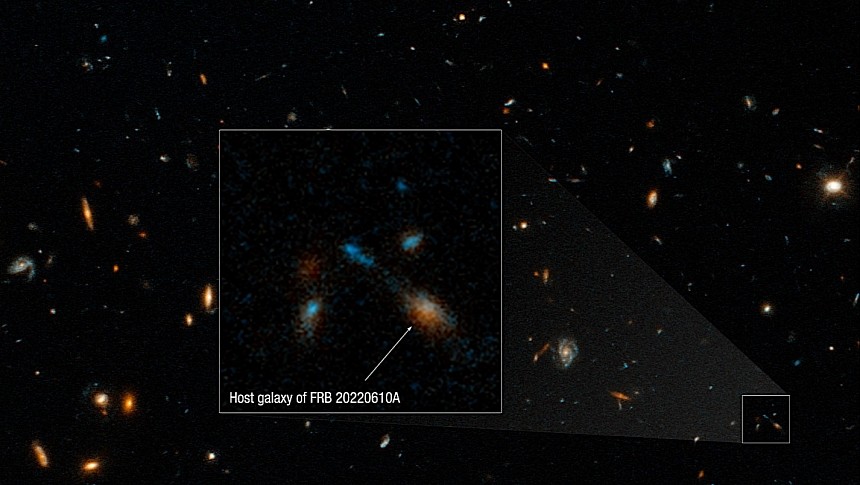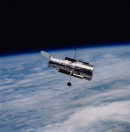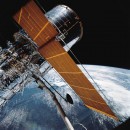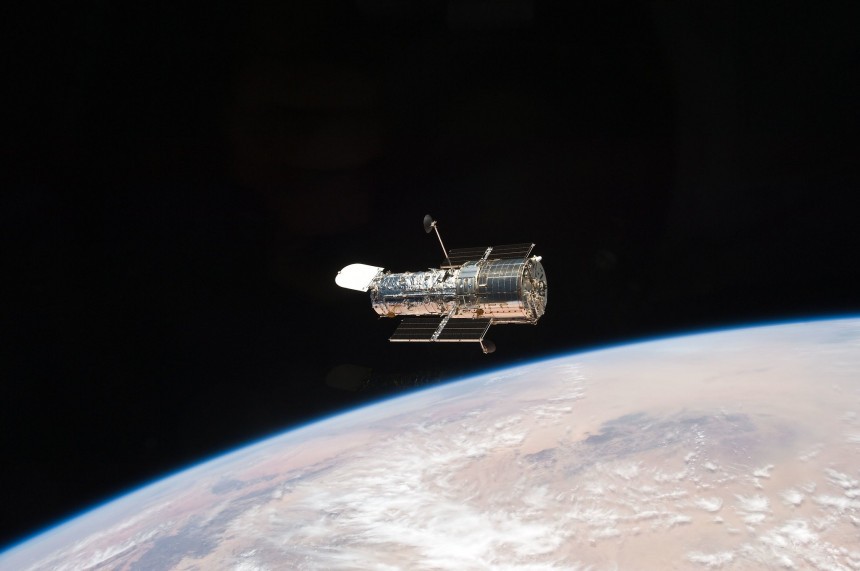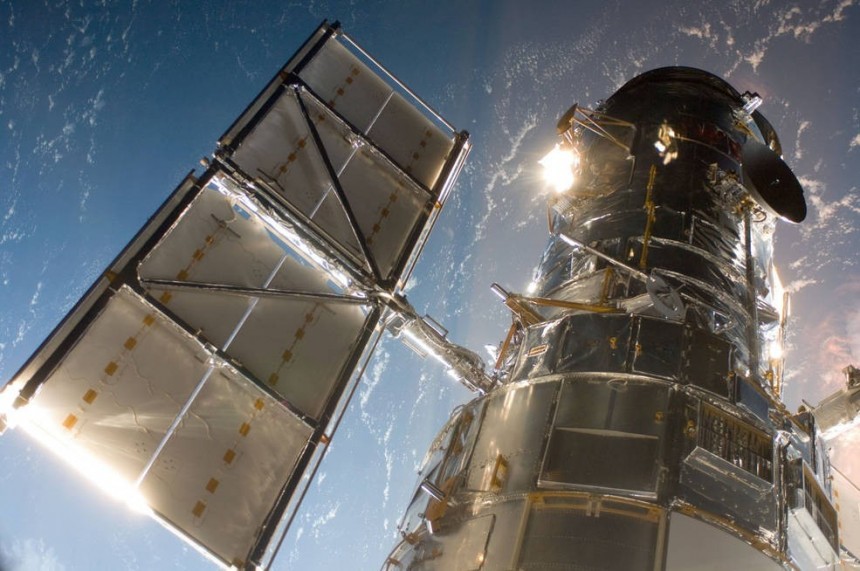The Hubble Space Telescope is one of the oldest and most important tools humans use to unravel the mysteries of the Universe. Launched in 1990, which is more than three decades ago, it helped our species advance our knowledge of the Universe to incredible levels. And it still seems to be doing that.
Hubble is considered by those studying space the most important telescope ever conceived. Its findings have rewritten astronomy textbooks, and many of the one million observations it is responsible for during its life are now being studied as the reality of our time.
The telescope's latest gimmick may shed a bit more light on some of our Universe's greatest mysteries, something astronomers refer to as fast radio burst, or FRB. In a nutshell, we’re talking about blasts of energy that, for very brief moments, are more visible than an entire galaxy.
They are called fast because they generally don't last for more than a fraction of a millisecond, but can reach in some cases up to three seconds. They are broadband, meaning they cover a large range of frequencies, and utterly mysterious, because we are yet to uncover what generates them, or why, or how.
Fast radio bursts are not localized to a certain point in the sky. They occur all over the Universe, with hundreds of them having been detected over the past few years. NASA compares them to camera flashes at a stadium event.
In the many instances FRBs have been detected the one brought into focus last week stands out as the farthest and most powerful ever observed. A “rare event in an oddball place” that has scientists baffled and scratching their heads, but also excited.
The event is called is astronomer speak FRB 20220610A. It first came under the spotlight back in 2022, when it was picked up by the Australian Square Kilometer Array Pathfinder (ASKAP) radio telescope in Western Australia.
It was considered back then one of the farthest such events ever discovered, a state of affairs later confirmed by the Very Large Telescope in Chile. How far, you ask? Well, it comes from a place whose light dates back to when the Universe was just 5 billion years old. That's from 8.5 billion years ago!
Now astronomers have trained the mighty Hubble on the place, trying to get a better understanding of the discovery, where it originated, and possibly even how.
What tops the list of strange things about this FRB is where it comes from, and its power. Generally speaking, such events have been detected in isolated galaxies, but this one originated in a region of space where no less than seven galaxies could be on the verge of merging. FRB 20220610A is also four times more energetic than other such events detected closer to home.
Finding such a distant and special radio burst could do wonders for our understanding of these spectacular manifestations of the Universe's power. Because, like it or not, FRBs are not considered to be signs of alien societies at work.
No one really knows what creates them, or how, but there are a few theories most scientists consider to be likely. The main idea is that radio bursts are created by either a black hole or a neutron star, like, say, a magnetar.
Magnetars are described by NASA as "the superheroes of the star world" for reasons I, to be honest, do not really understand. They are stars with magnetic fields so powerful (one trillion times more powerful than our Sun) that they could wipe the magnetic strips of all credit cards here on Earth from a distance of over 120,000 miles (190,000 km).
Some think these massive and massively powerful objects can suffer from time to time from something that's called a starquake. Just like here on Earth, it involves a sudden adjustment of a star's surface, and that may cause these sudden and brief bursts.
Separately, just like the Sun in our solar system does during solar flares, a magnetar's twisting magnetic field lines can snap from time to time, and then suddenly reconnect, creating radio bursts in the process.
The discovery of the most distant, most powerful radio burst to date could do wonders for our understanding of the phenomenon, helping us answer pressing questions like what generates them.
Scientists plan to increase the pace of RFB studies in the near future. We're promised an unprecedented rate in the number of FRBs detected at these distances (at, we're hoping, more new and interesting things about them), with the Hubble telescope to play, once again, a crucial role in the research (the hardware will probably continue to serve humanity's needs at least until the 2040s).
The findings on FRB 20220610A were presented by a team led by Alexa Gordon of Northwestern University in Evanston, Illinois during last week's 243rd meeting of the American Astronomical Society in New Orleans, Louisiana.
The telescope's latest gimmick may shed a bit more light on some of our Universe's greatest mysteries, something astronomers refer to as fast radio burst, or FRB. In a nutshell, we’re talking about blasts of energy that, for very brief moments, are more visible than an entire galaxy.
They are called fast because they generally don't last for more than a fraction of a millisecond, but can reach in some cases up to three seconds. They are broadband, meaning they cover a large range of frequencies, and utterly mysterious, because we are yet to uncover what generates them, or why, or how.
Fast radio bursts are not localized to a certain point in the sky. They occur all over the Universe, with hundreds of them having been detected over the past few years. NASA compares them to camera flashes at a stadium event.
In the many instances FRBs have been detected the one brought into focus last week stands out as the farthest and most powerful ever observed. A “rare event in an oddball place” that has scientists baffled and scratching their heads, but also excited.
The event is called is astronomer speak FRB 20220610A. It first came under the spotlight back in 2022, when it was picked up by the Australian Square Kilometer Array Pathfinder (ASKAP) radio telescope in Western Australia.
Now astronomers have trained the mighty Hubble on the place, trying to get a better understanding of the discovery, where it originated, and possibly even how.
What tops the list of strange things about this FRB is where it comes from, and its power. Generally speaking, such events have been detected in isolated galaxies, but this one originated in a region of space where no less than seven galaxies could be on the verge of merging. FRB 20220610A is also four times more energetic than other such events detected closer to home.
Finding such a distant and special radio burst could do wonders for our understanding of these spectacular manifestations of the Universe's power. Because, like it or not, FRBs are not considered to be signs of alien societies at work.
No one really knows what creates them, or how, but there are a few theories most scientists consider to be likely. The main idea is that radio bursts are created by either a black hole or a neutron star, like, say, a magnetar.
Magnetars are described by NASA as "the superheroes of the star world" for reasons I, to be honest, do not really understand. They are stars with magnetic fields so powerful (one trillion times more powerful than our Sun) that they could wipe the magnetic strips of all credit cards here on Earth from a distance of over 120,000 miles (190,000 km).
Separately, just like the Sun in our solar system does during solar flares, a magnetar's twisting magnetic field lines can snap from time to time, and then suddenly reconnect, creating radio bursts in the process.
The discovery of the most distant, most powerful radio burst to date could do wonders for our understanding of the phenomenon, helping us answer pressing questions like what generates them.
Scientists plan to increase the pace of RFB studies in the near future. We're promised an unprecedented rate in the number of FRBs detected at these distances (at, we're hoping, more new and interesting things about them), with the Hubble telescope to play, once again, a crucial role in the research (the hardware will probably continue to serve humanity's needs at least until the 2040s).
The findings on FRB 20220610A were presented by a team led by Alexa Gordon of Northwestern University in Evanston, Illinois during last week's 243rd meeting of the American Astronomical Society in New Orleans, Louisiana.
